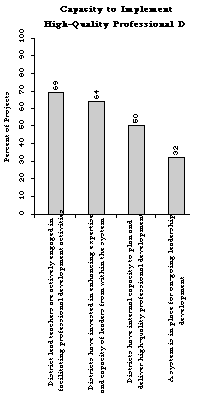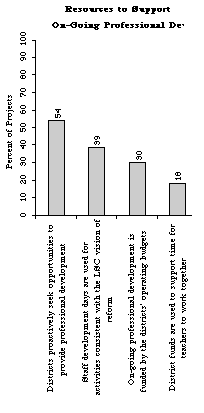Core Evaluation Question VI
How sustainable are the LSC reforms?
One of the "systemic" aspects of the LSC initiative is the expectation that districts will be able to sustain the reforms after the NSF funding period has ended. Evaluators were asked to rate the extent to which the participating districts have the capacity to implement high-quality professional development, the resources available to support it, and the structures in place to sustain high-quality professional development systems. As several evaluators noted, these ratings are based on a mixture of data and "impressions," but they do provide a broad indication of the status of the districts' professional development systems.
Evaluators were asked to indicate the "continuum level" which best describes the status of the professional development system within the targeted districts. As can be seen in Table 27, most Cohort 1 science projects were judged to be "transitioning toward a high-quality professional development system." Apparently, a number of the Cohort 2 districts had made progress towards institutionalizing high quality professional development systems prior to receiving the LSC awards, with a third of the projects rated as "emerging infrastructure" or even having already institutionalized such a system in the baseline year.
Table 27
Continuum Rating for Sustainability
|
Percent of Projects |
|
|
Cohort 1 |
Cohort 2 |
| Level 1: Predominance of Ineffective Professional Development System | 0 | 6 |
| Level 2: Exploring Components for High-Quality Professional Development System | 25 | 29 |
| Level 3: Transitioning Toward a High-Quality Professional Development System | 63 | 35 |
| Level 4: Emerging Infrastructure for High-Quality Professional Development System | 13 | 24 |
| Level 5: Institutionalization of a High-Quality Professional Development System | 0 | 6 |
While data from Cohort 1 projects are technically not "baseline," it is still early in the life of these projects to be looking for signs of sustainability. For that reason, and also because the Cohort 2 projects appear to have been further along in institutionalizing high-quality professional development at the time they began their LSC grants, evaluator ratings of individual aspects of sustainability are presented together in the following section.
Figure 73 provides information about the capacity of the LSC districts to implement high-quality professional development. Evaluators report that in roughly two-thirds of the projects, districts have invested in enhancing the expertise and capacity of lead teachers and that these teachers are actively engaged in facilitating professional development activities (based on the percentages responding 4 or 5 on a five-point scale from 1, "not at all" to 5, "to a great extent"). Somewhat fewer, 50 percent, indicated that the districts have the internal capacity to plan and deliver high-quality professional development, perhaps reflecting some evaluators' concerns about the quality of the professional development provided by lead teachers. Only one-third of the projects have systems in place for on-going leadership development.
Capacity to Implement High-Quality Professional Development

Figure 73
In addition to the capacity to provide high-quality professional development, districts will need resources to support these programs. Figure 74 shows the percent of evaluators assigning ratings of 4 or 5 (where 5 indicates "to a great extent") to each of a number of aspects of resource availability. Note that while in more than half of the LSC projects the districts actively seek opportunities to provide on-going, high-quality professional development experiences for their teachers, the use of district funds for these purposes is less common. Districts in 39 percent of the projects reportedly use staff development days for activities consistent with the LSC vision of reform, and in 30 percent of the projects, the districts provide funds for on-going professional development from their regular operating budgets.
Finally, districts will need structures in place to sustain high-quality professional development and provide a supportive context for exemplary instruction in science and mathematics. As can be seen in Figure 75, evaluators in less than half of the projects reported that the districts provide incentives for teachers to participate in on-going professional development (again, based on ratings of 4 or 5 on a five-point scale from 1, "not at all" to 5, "to a great deal"). And while 40 percent report structures in place for continuously assessing and improving their professional development systems, only 21 percent have mechanisms in place for monitoring policy alignment, and only 25 percent for maintaining support for reform among community stakeholders.
Resources to Support On-Going Professional Development

Figure 74
Structures for Sustaining High-Quality Professional Development

Figure 75
|

